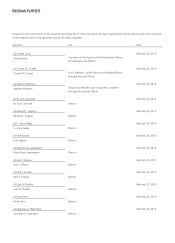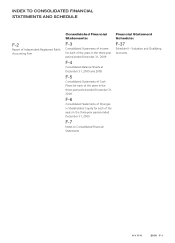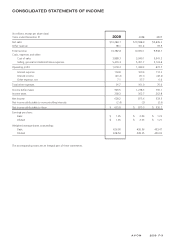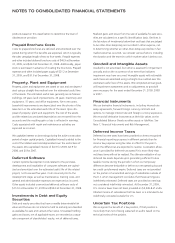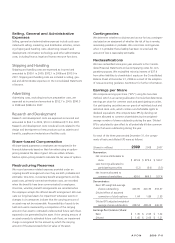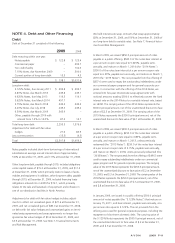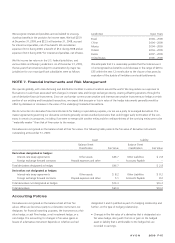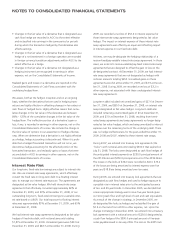Avon 2009 Annual Report Download - page 73
Download and view the complete annual report
Please find page 73 of the 2009 Avon annual report below. You can navigate through the pages in the report by either clicking on the pages listed below, or by using the keyword search tool below to find specific information within the annual report.
Selling, General and Administrative
Expenses
Selling, general and administrative expenses include costs asso-
ciated with selling; marketing; and distribution activities, includ-
ing shipping and handling costs; advertising; research and
development; information technology; and other administrative
costs, including finance, legal and human resource functions.
Shipping and Handling
Shipping and handling costs are expensed as incurred and
amounted to $939.1 in 2009, $972.1 in 2008 and $913.9 in
2007. Shipping and handling costs are included in selling, gen-
eral and administrative expenses on the Consolidated Statements
of Income.
Advertising
Advertising costs, excluding brochure preparation costs, are
expensed as incurred and amounted to $352.7 in 2009, $390.5
in 2008 and $368.4 in 2007.
Research and Development
Research and development costs are expensed as incurred and
amounted to $66.7 in 2009, $70.0 in 2008 and $71.8 in 2007.
Research and development costs include all costs related to the
design and development of new products such as salaries and
benefits, supplies and materials and facilities costs.
Share-based Compensation
All share-based payments to employees are recognized in the
financial statements based on their fair values using an option-
pricing model at thedate of grant. We use aBlack-Scholes-
Merton option-pricing model to calculate the fair value of options.
Restructuring Reserves
We record severance-related expenses provided under an
ongoing benefit arrangement once they are both probable and
estimable. One-time, involuntary benefit arrangements and dis-
posal costs, primarily contract termination costs, are recorded
when the benefits have been communicated to employees.
One-time, voluntary benefit arrangements are recorded when
the employee accepts the offered benefit arrangement. We eval-
uate our long-lived assets for impairment whenever events or
changes in circumstances indicate that the carrying amount of
an asset may not be recoverable. Recoverability of assets to be
held and used is measured by acomparison of the carrying
amount of an asset to estimated undiscounted future cash flows
expected to be generated by the asset. If the carrying amount of
an asset exceeds its estimated future cash flows, an impairment
charge is recognized for the amount by which the carrying
amount of the asset exceeds the fair value of the asset.
Contingencies
We determine whether to disclose and accrue for loss contingen-
cies based on an assessment of whether the risk of loss is remote,
reasonably possible or probable. We record loss contingencies
when it is probable that aliability has been incurred and the
amount of loss is reasonably estimable.
Reclassifications
We have reclassified some prior year amounts in the Consoli-
dated Financial Statements and accompanying notes for com-
parative purposes. We reclassified minority interest of $37.4
from other liabilities to shareholders’ equity on the Consolidated
Balance Sheet at December 31, 2008 as aresult of the adoption
of new accounting guidance. See Note 2for further information.
Earnings per Share
We compute earnings per share (“EPS”) using the two-class
method, which is an earnings allocation formula that determines
earnings per share for common stock and participatingsecurities.
Our participating securities are our grants of restricted stock and
restricted stock units, which contain non-forfeitable rights to
dividend equivalents. We compute basic EPS by dividing net
income allocated to common shareholders by the weighted-
average number of shares outstanding during the year. Diluted
EPS is calculated to give effect to all potentially dilutive common
shares that were outstanding during the year.
For each of the three years ended December 31, the compo-
nents of basic and diluted EPS were as follows:
(Shares in millions) 2009 2008 2007
Numerator:
Net income attributable to
Avon $625.8 $875.3 $530.7
Less: Earnings allocated to
participating securities (5.2) (6.0) (3.3)
Net income allocated to
common shareholders 620.6 869.3 527.4
Denominator:
Basic EPS weighted-average
shares outstanding 426.90 426.36 433.47
Diluted effect of assumed
conversion of stock options 1.64 1.89 2.55
Diluted EPS adjusted weighted-
average shares outstanding 428.54 428.25 436.02
Earnings Per Common Share:
Basic $1.45 $2.04 $1.22
Diluted $1.45 $2.03 $1.21
AVON2009 F-9



